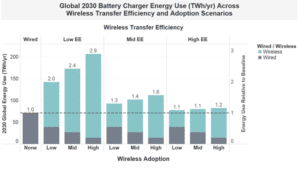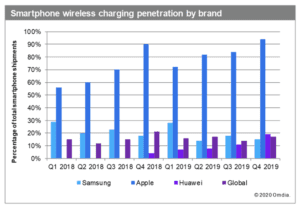Instant messaging business apps and most of the apps and devices that we use on a daily basis are completely wire-free. But what about our chargers? Wireless charging has already been around for a while, but it is now experiencing a real boom in popularity.
Is wireless charging good, and is it safe for your devices? To answer these questions and many more, read our guide of wireless charging.
What is wireless charging?
While the expression “wireless charging” may sound quite futuristic, the concept on which it is based is far from new. In fact, it all began a long time ago—in 1894, to be more precise. It was then that Nikola Tesla (the same person who inspired the technology behind the famous brand of electric cars) discovered magnetic induction—the foundation for our modern wireless charging systems.
In more recent years, wireless charging started to be used in many sectors and fields, enjoying significant popularity across the smart technology area. The main feature of wireless charging is that it removes the need to use wires, cables, or other types of physical connectors to charge a device.
What are the three types of wireless charging?
1. Magnetic induction
As we mentioned earlier on, magnetic induction is the core of wireless charging technology. This is one of the most common types of wireless charging available today and is widely used to charge smart technology devices.
The technology that powers wireless charging through magnetic induction is much easier than you would think. In a nutshell, when a device that features a wireless receiver coil is positioned on a charging pad featuring a transmitter coil, the battery of the device can intercept the magnetic field created by the charging station and, as a result, is able to charge.
2. Resonant wireless charging
Today, magnetic induction is not the only technology behind wireless charging. More recently, more complicated and powerful way to establish and transfer power between a receiver and a transmitter coil that operate at the same resonant frequency.
This method uses higher frequency of 6.78MHz or low-frequency ranges of 60-300kHz. This means that power can be generated and transferred between coils at much longer distances—around tens of centimeters apart from one another.
3. RF wireless charging
The third approach to wireless charging is using radio frequency or RF. Beyond the simple production of an electromagnetic field, RF chargers emit EMF waves and radio frequencies. By doing so, they transfer energy to the charging device through radio frequency waves—energy that is converted to electricity, and that in turn charges the device.
With RF wireless charging, the distance between a device and its charger can increase even more, also opening up the possibility of charging multiple devices at the same time. This interesting technology hasn’t yet been developed on a commercial level, although some initial tests have proven successful.
For example, it was demonstrated that RF charging can charge several smartphones at once, up to 15 feet away from the charger. This may sound really impressive, but it comes with some potential health hazards due to the transmission of higher-frequency waves.
7 benefits of wireless charging
According to many experts, wireless charging comes with a host of advantages. For example, this smarter system is safe and more eco-friendly than traditional charging systems. Keep reading to uncover the main advantages of wireless charging.
1. Wireless charging is safe
Safety should always be a priority when it comes to charging an electronic device. Wireless chargers are much safer than wired ones, as they are less prone to wear and tear, which in turn, can pose several safety hazards. Moreover, wireless charging also eliminates the occurrence of a power surge, which could damage your device or hurt you or other people.
2. Wireless charging is more convenient
The convenience of wireless charging is second to none. With no wires or cables needed, charging a device on-the-go becomes a real cinch. You can ensure that your devices are always fully charged and ready to be used, allowing you to deal with customers in a much better way – boosting both customer experience and satisfaction as a result.
3. Wireless charging has no overheating
Once your smart device has reached full charge, the wireless charger will shut down. This makes it much more environmentally conscious, while also decreasing the risk of overheating your device. All this benefits professionals working across the most disparate sectors—from retail to hospitality, from automotive to the services industry—who heavily rely on their smart devices to perform their daily tasks.
4. Wireless charging is clutter-free
When you are building a product, sometimes all you need is a clear mind and a neat, well-organized workspace to allow for full focus and productivity. With no cables in sight, a wireless charging system eliminates the clutter that you would usually have lying around your desk and allows you to concentrate on the task at hand.
5. Wireless charging is available in public areas
Do you need to charge your device while you are out and about? No problem, wireless charging lets you do just that, as it is increasingly more available in public spots. This can work great if you have an upcoming Dialpad conference call while you are out and about, and need to charge your device.
6. Wireless charging is more durable
How many traditional, wired chargers have you replaced since you bought your smartphone? Sometimes, they are too many to count, and this is because conventional types of chargers get worn out much more quickly and easily than their wireless counterparts.
7. Wireless charging has universal capabilities
Right now, if you need to charge several devices at the same time, you also need several different wires and connectors to do so. This changes completely if you move to wireless charging. With this technology, you can charge multiple smartphones at once: one single wireless charging pad, if it is big enough, has plenty of capacity to allow that.
Something like this would work a treat if you wanted, for example, to get one device fully charged for your next Zoom (or other Zoom alternatives) meeting, another one ready to respond to emails, and a third one up and running to watch this evening’s football game.
Is wireless charging safe for your device and does it reduce its battery life?
Pretty much all the devices that you use every day run on batteries, so you want to ensure that the charging approach that you follow is the best and safest one for the battery life of your devices. As we discussed earlier, one of the main advantages of using a wireless charger is that it is a safe charging method. It is, in fact, safer than using wires, cables, and connectors, as it eliminates lots of potential electrical hazards while also being more child and pet-friendly.
Despite some rumors that wireless charging may harm the battery life of, for example, certain Apple or Android phones, there has been no real evidence of damage. What might impact battery life, on the other hand, is the frequency with which you choose (or have to) charge your device: the more you do it, the worse it is for your battery.
Wireless charging in the future?
What will wireless charging look like in the future? Well, I think we can expect to see more wireless charging opportunities in public access areas, such as on trains and planes, and also in hotels and shared business spaces. We can also expect to see wireless charging from a greater distance rather than resting your phone on a wireless charging source. You may eventually experience automatic wireless charging just by being in a certain building.
Conclusion
Wireless charging systems are becoming increasingly popular, despite being based on technology that was first discovered over a century ago. In this blog, we delved deeper into what wireless charging is, how it works, and what its advantages are.
Are you going to try wireless charging for your personal or professional devices? We hope to have given you enough information for you to make an informed decision!
Want to know more visit www.powermat.com and check out the solutions.
Contributed Blog – Courtesy of Jessica Day – Senior Director, Marketing Strategy, Dialpad







